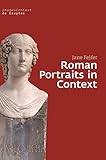Roman Portraits in Context / Jane Fejfer.
Material type: TextSeries: Image & Context ; 2Publisher: Berlin ; Boston : De Gruyter, [2009]Copyright date: ©2008Description: 1 online resource (592 p.) : div. Abb. s/w und in FarbeContent type:
TextSeries: Image & Context ; 2Publisher: Berlin ; Boston : De Gruyter, [2009]Copyright date: ©2008Description: 1 online resource (592 p.) : div. Abb. s/w und in FarbeContent type: - 9783110186642
- 9783110209990
- 733/.5 22
- NB1296.3 .F454 2008eb
- online - DeGruyter
- Issued also in print.
| Item type | Current library | Call number | URL | Status | Notes | Barcode | |
|---|---|---|---|---|---|---|---|
 eBook
eBook
|
Biblioteca "Angelicum" Pont. Univ. S.Tommaso d'Aquino Nuvola online | online - DeGruyter (Browse shelf(Opens below)) | Online access | Not for loan (Accesso limitato) | Accesso per gli utenti autorizzati / Access for authorized users | (dgr)9783110209990 |
Frontmatter -- Table of Contents -- Introduction -- Part One: Public Honours and Private Expectations -- The so-called Roman Private Portrait -- Corporates Spaces, Houses, Villas and Tombs -- Part Two: Modes of Representation -- The Material of Roman Portraits -- Statuary Body Types of Roman Men: All About Status? -- Abbreviated Formats -- Selves and Others: Ways of Expressing Identity in the Roman Male Portrait -- Part Three: The Empress and her Fellow Elite Women -- Roman Women in Public -- Part Four: The Emperor -- Representing the Roman Emperor -- Epilogue -- Power, Honour, and Memory -- Backmatter
restricted access online access with authorization star
http://purl.org/coar/access_right/c_16ec
Die höchste Ehre, die ein römischer Bürger sich erhoffen konnte, war eine Porträtstatue auf dem Forum seiner Stadt. Während der Kaiser und hohe Senatsbeamte regelmäßig mit solchen Statuen geehrt wurden, war die Konkurrenz unter den Wohltätern der Städte um diese Ehrung groß: ging es doch um nicht weniger, als die Erinnerung an den geehrten Patron und seine Familie über Generationen hin öffentlich zu verkünden und zu verewigen. Zwar gab es viele Möglichkeiten, sich eine Porträtstatue zu verdienen; die lokalen Honoratioren mussten jedoch oft bis nach ihrem Tod warten, bevor ihre Hoffnung darauf von der Öffentlichkeit erfüllt wurde. Jane Fejfer weist zum ersten Mal nach, wie grundsätzlich unser Verständnis und unsere Wahrnehmung von römischen Porträtstatuen erweitert werden, wenn wir folgende Faktoren einer systematischen Analyse unterziehen: den historischen Kontext, die ursprüngliche Aufstellung, die Entsehungsbedingungen von Herstellung und Stil – und den Sockel, auf dem in vielen Fällen ein Text angebracht war, der die suggestive Wirkung des Bildes durch eine eigene Rhetorik ergänzte.
The highest honour a Roman citizen could hope for was a portrait statue in the forum of his city. While the emperor and high senatorial officials were routinely awarded statues, strong competition existed among local benefactors to obtain this honour, which proclaimed and perpetuated the memory of the patron and his family for generations. There were many ways to earn a portrait statue but such local figures often had to wait until they had passed away before the public finally fulfilled their expectations. It is argued in this book that our understanding and contemplation of a Roman portrait statue is greatly enriched, when we consider its wider historical context, its original setting, the circumstances of its production and style, and its base which, in many cases, bore a text that contributed to the rhetorical power of the image.
Issued also in print.
Mode of access: Internet via World Wide Web.
In English.
Description based on online resource; title from PDF title page (publisher's Web site, viewed 28. Feb 2023)


